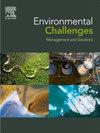How effective and efficient is the generation of nature-based carbon removal quantified according to the regulation on carbon removal and carbon farming certification? An evaluation based on the example of a hypothetical agroforestry system in Baden-Württemberg
Q2 Environmental Science
引用次数: 0
Abstract
Nature-based carbon removal (CR) could play a key role in achieving climate neutrality but it does face quantification challenges. This study evaluates the effectiveness and efficiency of CR quantification under the Carbon Removals and Carbon Farming (CRCF) Regulation, using Baden-Württemberg (Germany) as a case study. We designed a hypothetical agroforestry system for valuable timber production compliant with the CRCF requirements, modelling potential GHG emission reductions and the benefit-potential ratio (share of the CRCF-compliant net CR benefit within the total GHG emission mitigation potential). The results revealed a significant shortfall between the total GHG mitigation potential (350 kt CO2eq) and the actual net CR benefit (205 kt CO2eq), representing only 5 % of BW’s agricultural emissions. The benefit-potential ratio was at most 59 %, with abatement costs ranging from €59 to €153 t CO2eq-1. Conservative estimates to improve reliability further lowered the ratio to 24 %, pushing costs to €244 t CO2eq-1. While agroforestry does manifest regional CR generation potential, it is unlikely to contribute significantly to large-scale CR under the current CRCF framework, as both flaws within its quantification base and the inherent properties of nature-based CR limit its effectiveness. Although transferability is restricted by focusing on valuable timber production in BW, our results highlighted the need for harmonized emission factors, system boundary definitions (particularly indirect land use change), and a clear distinction between CR (e.g., from carbon sequestration in soils) and reduced soil emissions. We advocate balancing the use of agroforestry with more durable CR strategies and imposing caps on nature-based CR contributions to ensure robust climate action.
根据碳去除和碳养殖认证的规定,如何量化基于自然的碳去除的产生效果和效率?以巴登-符腾堡州一个假设的农林复合系统为例进行评价
基于自然的碳去除(CR)可以在实现气候中和中发挥关键作用,但它确实面临量化挑战。本研究以德国巴登-符腾堡州(baden - w rttemberg)为例,评估了碳清除和碳养殖(CRCF)法规下碳排放量化的有效性和效率。我们设计了一个假设的农林业系统,用于符合CRCF要求的有价值木材生产,模拟潜在的温室气体减排和效益-潜力比(符合CRCF的净CR效益在温室气体减排总潜力中的份额)。结果显示,总温室气体缓解潜力(350千万吨二氧化碳当量)与实际净CR效益(205千万吨二氧化碳当量)之间存在显著差距,仅占BW农业排放量的5%。效益潜力比最多为59%,减排成本从59欧元到153欧元不等。据保守估计,为了提高可靠性,该比率进一步降至24%,将成本推至244t / co2 / q-1。虽然农林业确实表现出区域CR生成潜力,但在当前的CRCF框架下,它不太可能对大规模CR做出显著贡献,因为其量化基础的缺陷和基于自然的CR的固有特性限制了其有效性。尽管可转移性因关注森林中有价值的木材生产而受到限制,但我们的研究结果强调了协调排放因子、系统边界定义(特别是间接土地利用变化)以及明确区分CR(例如,来自土壤中的碳固存)和减少土壤排放的必要性。我们主张在农林业的使用与更持久的社会责任战略之间取得平衡,并对基于自然的社会责任贡献设定上限,以确保采取强有力的气候行动。
本文章由计算机程序翻译,如有差异,请以英文原文为准。
求助全文
约1分钟内获得全文
求助全文
来源期刊

Environmental Challenges
Environmental Science-Environmental Engineering
CiteScore
8.00
自引率
0.00%
发文量
249
审稿时长
8 weeks
 求助内容:
求助内容: 应助结果提醒方式:
应助结果提醒方式:


